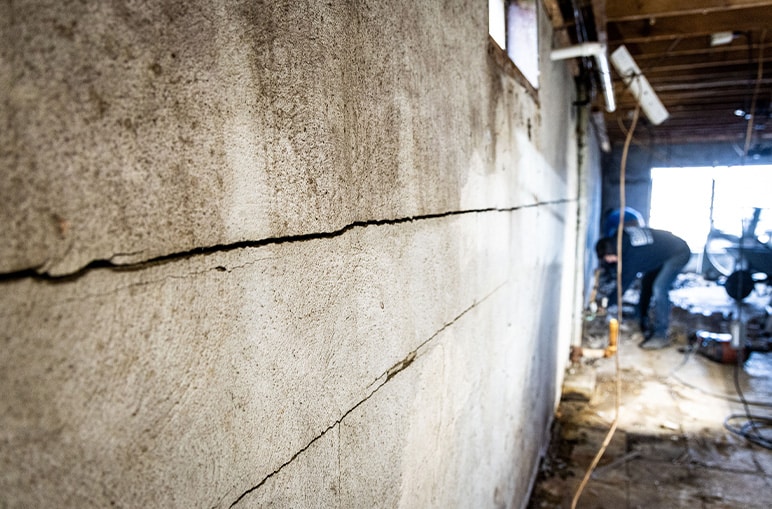How to Identify Cracks in Floors, Walls, and Ceilings
Cracks in your home’s floors, walls, or ceilings can make any homeowner uneasy. The big question is: are these just cosmetic blemishes, or do they signal something more serious with your foundation?
The truth is, not all cracks are created equal. Some are harmless and easy to fix, while others can be warning signs of deeper structural issues that put your home’s safety and value at risk.
In this guide, we’ll walk you through the different types of cracks to watch for, what they mean, and when it’s time to call in a foundation repair professional.
Why Cracks Appear in Your Home
Cracks don’t just show up out of nowhere. They usually form because of natural forces at work on your home over time. As concrete cures, wood frames expand and contract, or soil shifts beneath your foundation, your home adjusts to these changes.
Sometimes this results in small, harmless cracks. But other times, the same forces can create pressure and stress that lead to significant foundation damage.
Some of the most common causes of cracks include:
- Normal settling as your home adjusts to the soil it sits on.
- Moisture changes in the ground that cause soil to expand or shrink.
- Temperature fluctuations that make building materials expand and contract.
- Poor drainage or water intrusion, which can weaken the foundation and surrounding soil.
Understanding these causes is the first step to recognizing which cracks are no big deal and which ones need professional attention before they get worse.
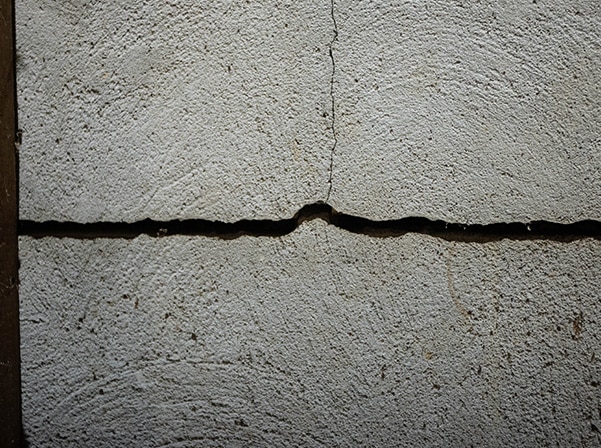
Common Types of Cracks in Floors
Floors are often one of the first places homeowners notice cracks. Because your floors carry the weight of your home and everything inside it, cracks here can be especially concerning. While some are simply cosmetic, others point to foundation settlement or sinking concrete that needs repair. Here’s how to tell the difference:
Hairline Cracks
Hairline cracks are thin, shallow lines in concrete slabs or basement floors. These usually occur when concrete cures and shrinks slightly after being poured. On their own, they’re typically not a structural concern. Still, it’s smart to keep an eye on them. If they start spreading or widening, that could mean your foundation is shifting.
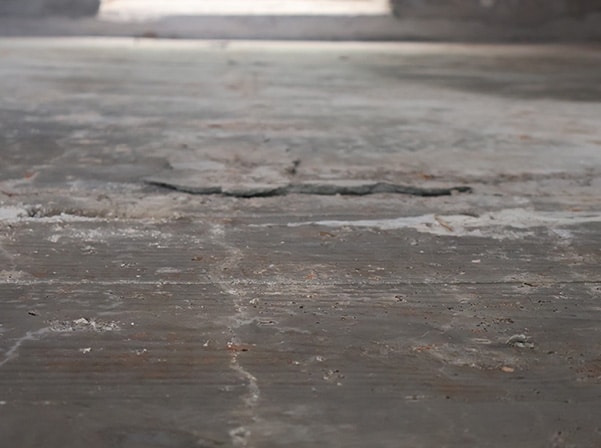
Wide or Spreading Cracks
Cracks that grow wider over time or start spreading across large areas are a red flag. These can indicate foundation settlement or problems with the soil beneath your slab. Left untreated, they can lead to uneven floors, tripping hazards, and damage that requires more extensive repair.
Cracks with Uneven Surfaces
When one side of a crack sits higher than the other, it often means the slab is sinking or lifting. This type of damage is more than cosmetic; it signals that the ground beneath your foundation or concrete surface is unstable. Professional solutions like concrete leveling can restore safety and stability while preventing the problem from getting worse.
Identifying Cracks in Walls
Wall cracks can tell you a lot about what’s happening with your home’s structure. While some are minor cosmetic issues, others are strong indicators of foundation movement or hydrostatic pressure against your basement walls.
Knowing what each type looks like can help you decide whether a simple patch is enough or if it’s time to call in a professional.
Vertical Cracks
Vertical cracks are the most common type you’ll see in walls. They often appear as straight lines running up and down, and many times they’re caused by normal settling of the foundation. If they remain narrow and stable, they’re usually not serious. However, wider vertical cracks can allow water seepage into your basement or crawl space, which should be addressed.
Horizontal Cracks
Horizontal cracks are a major red flag. They usually signal that your foundation walls are bowing or being pushed inward by pressure from expanding soil or excess water. These cracks are considered structural issues and almost always require professional repair, such as wall stabilization systems.
Stairstep Cracks in Brick or Block Walls
Stairstep cracks follow the mortar joints in a zig-zag pattern. These are classic signs of foundation movement, often caused by uneven settling or soil shifts beneath the home. Small ones might look harmless, but if they continue to grow, they point to serious foundation stress that should not be ignored.
Diagonal Cracks from Windows or Doors
When cracks angle out from corners of windows and doors, it often means your foundation is settling unevenly. This movement can also make doors stick, windows jam, or trim pull away from walls. These symptoms together suggest your home’s foundation may need stabilization.
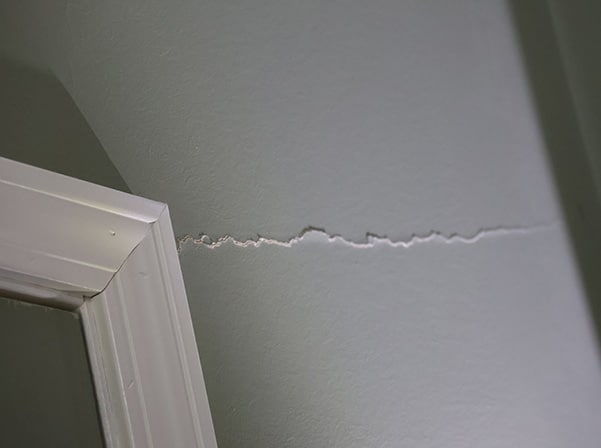
Ceiling Cracks and What They Mean
Ceiling cracks often go unnoticed until they become more obvious, but they can reveal just as much about your home’s condition as floor or wall cracks. Some are harmless and related to normal settling, while others are linked to structural stress that needs immediate attention. Here are the most common types:
Hairline Ceiling Cracks
These thin, shallow cracks are usually the result of drywall shrinkage, plaster settling, or slight shifts in the home’s frame. On their own, they’re generally cosmetic. A little patching and paint can often take care of them.
Still, if hairline cracks begin to spread or appear in multiple areas, it’s worth monitoring more closely.
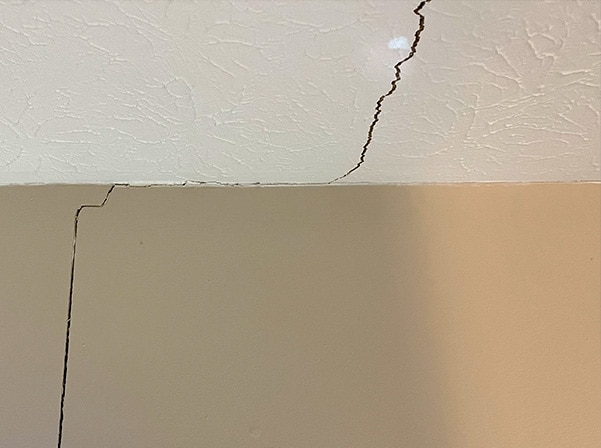
Large, Jagged, or Spreading Cracks
Wide or irregular cracks across the ceiling are a bigger concern. They can point to issues with the structure above, such as sagging joists or foundation movement that’s affecting your entire home.
If these cracks keep getting worse, they’re not just cosmetic, they’re a sign of a deeper problem that calls for professional inspection.
Cracks Along Ceiling and Wall Junctions
When cracks appear where the ceiling meets the walls, it often means your home is shifting or settling unevenly. This kind of movement is sometimes linked to foundation settlement, which can also cause sloping floors and sticking doors.
Addressing the root cause early can prevent further structural damage.
When Cracks Signal Bigger Problems
Not every crack in your home is cause for panic, but some definitely point to deeper foundation issues. The key is knowing when a simple patch won’t cut it.
Cracks that keep widening, appear suddenly, or are accompanied by other symptoms should be taken seriously. Here are a few warning signs that it’s time to call in a professional:
- Sticking doors and windows – If cracks are paired with windows that won’t open smoothly or doors that drag, your foundation may be shifting.
- Sloping or uneven floors – Cracks in floors plus a noticeable slope can indicate settlement or sinking concrete.
- Water intrusion or dampness – Cracks that let in water create the perfect environment for basement mold and wood rot.
- Musty odors or mold growth – Structural cracks often go hand in hand with moisture problems, which can affect indoor air quality.
- Rapidly expanding cracks – Any crack that seems to grow wider or longer in a short time frame is a major red flag.
If you notice one or more of these symptoms alongside cracks in your floors, walls, or ceilings, it’s a good idea to schedule a professional foundation inspection right away. Catching the problem early can save you from larger, more expensive repairs down the road.
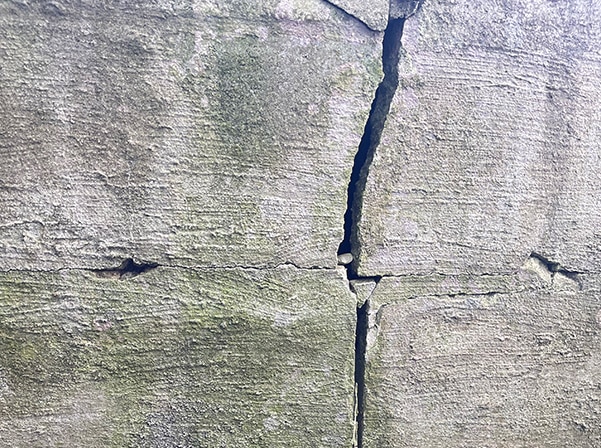
DIY Monitoring vs. Professional Repair
It’s tempting to grab a tube of sealant or a concrete patch kit when you see cracks, but not all repairs are as simple as they look. While homeowners can take some steps to monitor and manage minor cracks, relying solely on DIY fixes can create bigger problems later.
What you can do as a homeowner:
- Measure and monitor – Keep track of crack length and width using a simple ruler or crack monitor. Note any changes over time.
- Seal minor surface cracks – For hairline cracks that aren’t spreading, applying a waterproof sealant can help keep out moisture.
- Control moisture – Use dehumidifiers or improve drainage around your home to reduce the conditions that make cracks worse.
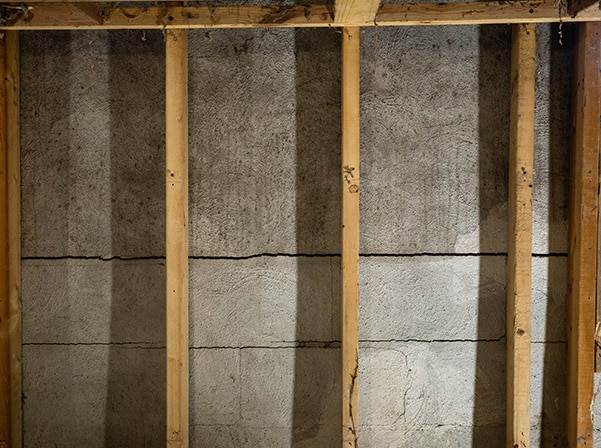
Why professional repair makes sense:
- Proper diagnosis – A foundation repair expert can tell the difference between harmless cosmetic cracks and those that threaten your home’s structure.
- Long-lasting solutions – Professional repairs, such as pier systems or concrete leveling, address the root cause instead of just covering up symptoms.
- Peace of mind – Knowing your home is structurally sound removes the stress of wondering if a crack will turn into a major repair bill.
DIY fixes can buy you a little time, but they’re rarely a true solution. If you’re unsure whether a crack is cosmetic or structural, it’s best to have a professional inspection for clarity and confidence.
Protecting Your Home from Future Cracks
The best way to deal with cracks is to stop them from happening in the first place or at least prevent small ones from turning into bigger problems.
While you can’t control every factor, there are steps you can take to protect your foundation and reduce the risk of structural damage.
Smart ways to prevent future cracks include:
- Improve drainage around your home – Keep gutters clean, extend downspouts, and make sure the soil slopes away from your foundation to prevent water from pooling.
- Invest in basement waterproofing – Sealing your basement keeps moisture out, reducing hydrostatic pressure that can crack walls and floors.
- Encapsulate your crawl space – A sealed crawl space with a vapor barrier and dehumidifier helps control moisture under your home, protecting against mold, wood rot, and settlement.
- Install a sump pump – A reliable sump pump system can prevent water buildup that weakens soil and creates pressure against your foundation.
- Schedule regular inspections – Having a professional check your foundation every few years helps catch small issues before they turn costly.
These preventative measures not only protect your home’s structure but also improve indoor air quality, reduce energy bills, and give you long-term peace of mind.
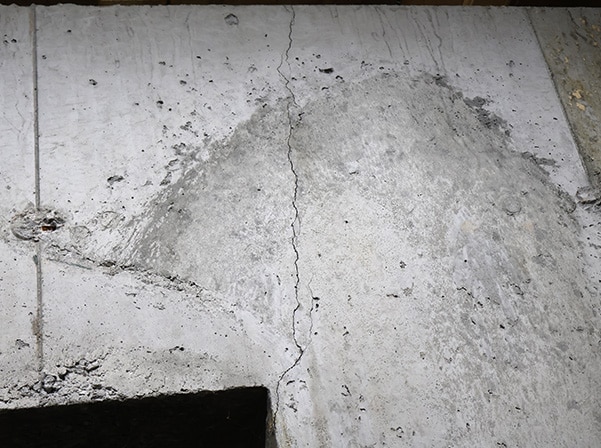
Schedule a Free Inspection with Foundation Solutions Group
When it comes to cracks in your floors, walls, or ceilings, peace of mind starts with answers. At Foundation Solutions Group, our team specializes in diagnosing the difference between harmless cosmetic cracks and serious foundation issues.

We offer free, no-obligation inspections so you can understand exactly what’s happening in your home before deciding on next steps.
If repairs are needed, we’ll recommend the best solution to restore your home’s safety and value. Whether that’s foundation repair, basement waterproofing, or crawl space encapsulation. With professional care, you can stop worrying about cracks and start feeling confident in your home again.
Don’t wait for cracks to get worse. Schedule your free inspection today.

Written By Shaun Miller, Owner Foundation Solutions Group
Shaun Miller is the owner of Foundation Solutions Group, a trusted foundation repair and waterproofing company serving South Central Kentucky and Middle Tennessee. With over 20 years of experience, Shaun is committed to delivering quality craftsmanship and ensuring that every project is done right the first time, backed by the company’s “Fix-It-Forever Guarantee.” Passionate about educating homeowners, Shaun leads the company’s "Solutions University" initiative to help clients protect their homes through knowledge and preventative care. Dedicated to his community, Shaun also supports local organizations and values the trust his customers place in him.

